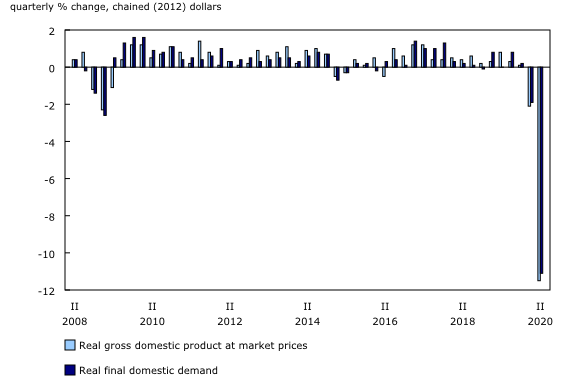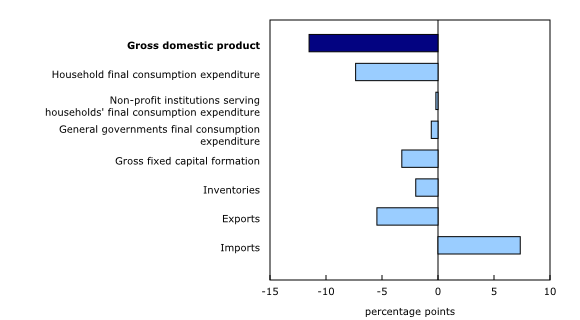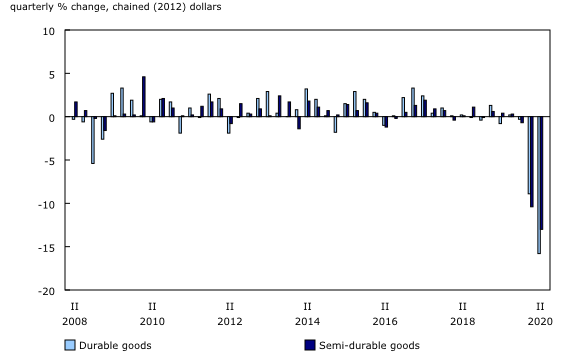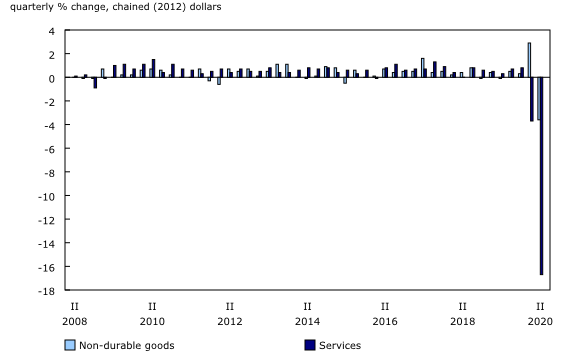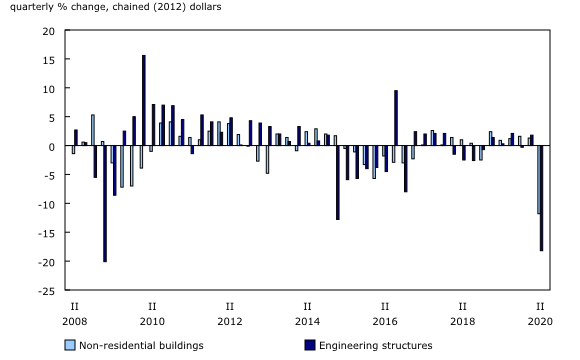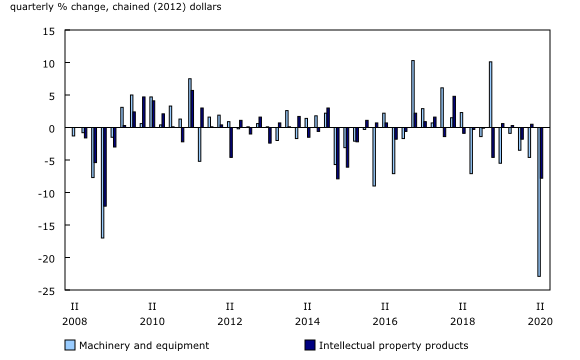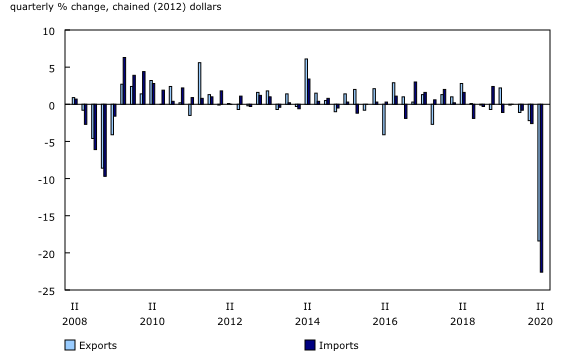Gross domestic product, income and expenditure, second quarter 2020
Archived Content
Information identified as archived is provided for reference, research or recordkeeping purposes. It is not subject to the Government of Canada Web Standards and has not been altered or updated since it was archived. Please "contact us" to request a format other than those available.
Released: 2020-08-28
Real gross domestic product (GDP) fell 11.5% in the second quarter, following a 2.1% decline in the first quarter. The second quarter decline—the steepest since quarterly data were first recorded in 1961—reflected sharp decreases in household spending, business investment, and international trade owing to widespread shutdowns of non-essential businesses, border closures, and restrictions on travel and tourism in response to the COVID-19 pandemic.
Final domestic demand fell 11.1%, continuing the 1.9% drop in the first quarter.
Expressed at an annualized rate, real GDP fell 38.7% in the second quarter. In contrast, real GDP in the United States fell 31.7%.
Impacts of the COVID-19 pandemic
With the constraints imposed on economic activities to curtail the pandemic, the Canadian economy contracted sharply in the second quarter of 2020. The impacts of shutdowns of non-essential businesses, restrictions of travel and tourism, and border closures were exacerbated by sharp quarterly declines in major trading partners' economies, such as the United States (-9.1%), the United Kingdom (-20.4%), France (-13.8%), Italy (-12.4%) and Japan (-7.8%).
As measures by governments to contain the pandemic have been relaxed, economic activity has increased. Therefore, third-quarter GDP is expected to rise.
Most GDP components posted a record decline in the second quarter. A 13.1% drop in household spending was attributable to substantial job losses and limited opportunities to spend because of closures of stores and restaurants and restrictions on travel and tourism.
Business investment fell 16.2%, reflecting limited construction activities, plant closures, low oil prices and heightened uncertainty. Export volumes declined 18.4% and import volumes dropped 22.6%, as major trading partners' economies shrank owing to their adoption of measures to contain the pandemic.
Faced with lower imports and supply chain disruptions, businesses drew down $37.7 billion in inventories. A large decline in sales volumes, which resulted from store closures and lower household demand, pushed the economy-wide stock-to-sales ratio from 0.878 in the first quarter to 0.976 in the second quarter.
Record decline in household spending
Declines in household spending were pronounced and widespread, affecting both goods (-8.4%) and services (-16.7%).
Outlays for durable goods fell 15.8%, the steepest drop ever recorded. Substantial declines occurred in purchases of new passenger cars (-37.8%), new trucks, vans and sport utility vehicles (-26.4%), and used motor vehicles (-23.9%), reflecting closures of car dealerships, income uncertainty, and reduced transportation needs as working remotely became more widespread for some professions. Outlays for semi-durable goods fell 13.0%, led by garments (-25.3%), clothing materials (-38.3%) and footwear (-20.3%).
Outlays for non-durable goods fell 3.6%, after rising 2.9% in the first quarter. The decline in outlays for services (-16.7%) was attributable to food, beverage, and accommodation services (-45.6%) and transportation services (-79.2%).
Housing investment falls
A sharp decline in housing investment (-14.9%) was attributable to physical distancing measures as well as construction stoppages.
The decline was led by ownership transfer costs (-34.3%), followed by renovations (-11.0%) and new construction (-8.1%). The drop in ownership transfer costs was widespread, but particularly pronounced in British Columbia and Ontario, as home resale activities in nearly all major urban centres were halted in April. New construction of single-unit and multiple-unit dwellings was down substantially, with Quebec posting the largest decline.
With the relaxation of restrictions and reductions in uncertainty, housing investment is expected to increase.
Non-residential business investments contract at record pace
A record decrease in business investment (-16.2%) was due to shutdowns, reduced demand for transportation because of travel restrictions and the growing prevalence of working and schooling at home, and uncertainty about the global economy.
Business investment in machinery equipment fell 22.9%, led by declines in passenger cars (-93.8%), trucks, buses and motor vehicles (-89.4%), and aircraft and other transportation equipment (-43.4%). Business investments fell in engineering structures (-18.2%) and non-residential buildings (-11.8%).
Investment in intellectual property products dropped 7.8%. Sharp declines in research and development (-14.3%) and mineral exploration (-29.0%) were moderated by a smaller decline in software (-0.7%).
Sharp decline in export and import volumes
Sharp declines in export (-18.4%) and import (-22.6%) volumes occurred, as major trading partners (the United States, China, and most European countries) also shut down production plants, closed borders to tourism, and curtailed non-essential travel.
Substantial declines in export volumes occurred in motor vehicles and parts (-56.6%), industrial machinery and equipment (-22.7%), aircraft and aircraft engines (-38.4%), intermediate metal products (-13.6%), travel services (-53.2%) and transportation services (-31.3%). These declines were slightly moderated by increased exports of farm and fishing products (+12.8%), nuclear fuel (+24.2%), and pharmaceutical and medicinal products (+4.1%).
Steep declines in import volumes were led by motor vehicles and parts (-67.5%), aircraft and aircraft engines (-50.3%), crude oil and crude bitumen (-29.7%), industrial machinery and equipment (-21.2%), travel services (-86.3%) and transportation services (-37.5%). These declines were partly offset by increases in imports of metal ores and concentrates (+45.8%) and intermediate metal products (+11.1%).
Terms-of-trade deteriorates and real gross national income drops
A 5.7% decline in export prices was attributable to a sharp drop (-54.7%) in prices of exported crude oil and crude bitumen and lower international demand for most products. Import prices fell 2.2%, owing to lower demand on the world market. Consequently, the terms-of-trade—the ratio of the price of exports to the price of imports—fell 3.6%. Decreased terms-of-trade contributed to lower real gross national income (-12.5%), which captures the real purchasing power of income earned by Canadian-owned production factors.
The GDP implicit price index, which reflects the overall price of domestically produced goods and services, fell 1.2% in the second quarter.
Corporate earnings fall, but household savings rise
In nominal terms, the gross operating surplus declined for both non-financial (-13.3%) and financial (-6.0%) corporations. Low oil prices affected the revenue of businesses involved in the oil and gas sector; pandemic-related restrictions affected all non-essential businesses, including those involved with transportation, tourism and accommodation services. Further declines were mitigated by the Canadian Emergency Wage Subsidy, which made it possible for employers to continue to pay employees.
Compensation of employees fell 8.9%—the steepest drop ever recorded. The majority of industries experienced declines, led by personal and professional services, construction, manufacturing, and wholesale and retail trade.
Although compensation of employees dropped considerably in the quarter, this was more than offset by a significant increase in government transfers to households, meant to blunt the impact of the COVID-19-related measures; the result was a 10.8% increase in household disposable income. This increase, coupled with a 13.7% decline in household spending (in nominal terms), pushed the household saving rate to 28.2% from 7.6% in the previous quarter. The household savings rate is aggregated across all income brackets; in general, savings rates are higher for higher income brackets.
Sustainable development goals
On January 1, 2016, the world officially began implementing the 2030 Agenda for Sustainable Development—the United Nations' transformative plan of action that addresses urgent global challenges over the next 15 years. The plan is based on 17 specific sustainable development goals.
Data on gross domestic product, income and expenditure are an example of how Statistics Canada supports the reporting on the global sustainable development goals. This release will be used to measure the following goals:


Note to readers
Revisions to first-quarter gross domestic product
When first-quarter data were released on May 29, Statistics Canada's data collection and compilation were hampered by the sudden imposition of work restrictions and technical and operational constraints. Subsequently, Statistics Canada was able to overcome those limitations and produce revised first-quarter data, which are included with this release. The following surveys had been impacted, but are now fully operational:
Building construction investment: Source data on building construction, including work-put-in-place for residential and non-residential building investment were not available when first-quarter data were compiled. First-quarter results were estimated using proxy indicators of labour and material costs, as well as data from the Canada Mortgage and Housing Corporation. The present release incorporated the previously unavailable source data, along with other indicators, for both quarters.
Financial data on corporations: Data from the Quarterly Survey of Financial Statements were unavailable at the time of first quarter gross domestic product (GDP) estimation; consequently, data were based on in-progress estimates rather than the final results. This release applied the final results for both quarters.
Spending on motor vehicles: Data from the monthly New Motor Vehicle Sales Survey (NMVS) for March were not available at the time of compilation of the first quarter. Results were estimated using alternative sources, including the volume of motor vehicle registrations, combined with prices from the auto industry. With the availability of NMVS data, first-quarter estimates were revised.
In addition to previously unavailable data sources, first-quarter estimates were revised with updates to source data for many GDP components. These updates include late-filler data for trade, updated surveys, and input prices. Notably the overall revision was negligible as downward revisions in some components were nullified by upward revisions in other components.
Support measures by governments
To alleviate the economic impact of the COVID-19 pandemic, governments have implemented a number of programs, including Canada Emergency Wage Subsidy and Canada Emergency Response Benefit. For a comprehensive explanation of how government support measures were treated in compilation of the estimates, see the report ''Recording COVID-19 measures in the national accounts.''
Percentage changes for expenditure-based statistics (such as household spending, investment, and exports) are calculated from volume measures that are adjusted for price variations. Percentage changes for income-based statistics (such as compensation of employees and operating surplus) are calculated from nominal values; that is, they are not adjusted for price variations.
There are two ways of expressing growth rates for GDP and other time series:
- Unless otherwise stated, growth rates represent the percentage change in the series from one quarter to the next, such as from the fourth quarter of 2019 to the first quarter of 2020.
- Quarterly growth can also be expressed at an annual rate by using a compound growth formula, similar to the way in which a monthly interest rate can be expressed at an annual rate. This growth rate is cited for comparisons with the United States. Both formulas represent the latest period-to-period quarterly growth.
For information on seasonal adjustment, see Seasonally adjusted data – Frequently asked questions.
For more information on GDP, see the video "What is Gross Domestic Product (GDP)?"
Revisions
Data on GDP for the second quarter have been released along with revised data for the first quarter of 2020. These data incorporate new and revised data, as well as updated data on seasonal trends.
Real-time tables
Real-time tables 36-10-0430-01 and 36-10-0431-01 will be updated on September 8.
Next release
Data on GDP by income and expenditure for the third quarter will be released on December 1.
Products
The document, "Recording COVID-19 measures in the national accounts," which is part of Latest Developments in the Canadian Economic Accounts (13-605-X), is available.
The product Cannabis Stats Hub (13-610-X) is available.
The Economic accounts statistics portal, accessible from the Subjects module of our website, features an up-to-date portrait of national and provincial economies and their structure.
The User Guide: Canadian System of Macroeconomic Accounts (13-606-G) is available.
The Methodological Guide: Canadian System of Macroeconomic Accounts (13-607-X) is available.
Contact information
For more information, or to enquire about the concepts, methods or data quality of this release, contact us (toll-free 1-800-263-1136; 514-283-8300; STATCAN.infostats-infostats.STATCAN@canada.ca) or Media Relations (613-951-4636; STATCAN.mediahotline-ligneinfomedias.STATCAN@canada.ca).
- Date modified:




